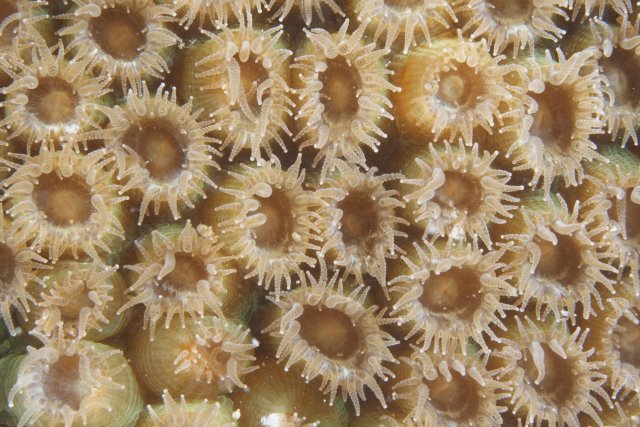How Many Species Of Animals Live In Coral Reefs
On this page:
- What are coral reefs?
- Where are coral reefs found?
- Why are coral reefs important?
What are Coral Reefs?
Coral reef ecosystems are intricate and diverse collections of species that interact with each other and the physical environment. Coral is a class of colonial animal that is related to hydroids, jellyfish, and ocean anemones.
Stony corals, a type of coral characterized by their hard skeleton, are the bedrock of the reef. Stony coral colonies are composed of hundreds of thousands of individual living polyps. Polyps are capable of cartoon dissolved calcium from seawater, and solidifying information technology into a difficult mineral (calcium carbonate) structure that serves as their skeletal back up. When you expect at a coral colony, only the thin layer on its surface is live coral; the mass beneath is the calcium carbonate skeleton that may be decades old.

The deadening growth of polyps and expansion of the hard skeletal structures build up the permanent coral reef structure over fourth dimension.
Polyps of reef-building corals contain microscopic algae called zooxanthellae, which exist with the animal in a symbiotic relationship. The coral polyps (animals) provide the algae (plants) a home, and in exchange the algae provide the polyps with food they generate through photosynthesis. Because photosynthesis requires sunlight, most reef-building corals live in articulate, shallow waters that are penetrated by sunlight. The algae also requite a coral its color; coral polyps are really transparent, so the color of the algae within the polyps prove through.
Coral reefs provide habitat for a large variety of marine life, including diverse sponges, oysters, clams, crabs, ocean stars, sea urchins, and many species of fish. Coral reefs are also linked ecologically to nearby seagrass, mangrove, and mudflat communities. One of the reasons that coral reefs are so highly valued is considering they serve as a eye of activity for marine life.
Not all corals on the reef are stony corals.
- Hydrocorals , or fire coral, are reef-building hydroids that have a difficult calcareous exoskeleton and stinging cells that can crusade a burning sensation when touched.
- Octocorals , or 'soft' corals, include sea fans and bounding main whips, which grow more than like fleshy plants and practise non class calcium carbonate skeletal structures.
- Antipatharians , or black corals, are another type of branching 'soft' coral.
Some soft corals have zooxanthellae to acquire food and energy, just others, such as black corals, be without this symbiotic relationship.
Where are Coral Reefs Found?
Corals can be found throughout the world's oceans, in both shallow and deep water. Yet, the reef-building corals that rely on a symbiotic relationship with algae need shallow, articulate h2o allowing lite penetration for photosynthesis. Stony corals also require tropical or sub-tropical temperatures, which exist in a band xxx degrees n to thirty degrees south of the equator.

Coral reefs exist in seven U.S. states and territories, including:
- Florida,
- Puerto Rico,
- U.Southward. Virgin Islands,
- Hawaiʻi, and
- Guam, American Samoa, and the Republic of the Northern Mariana Islands.
There are also coral reefs 100 miles offshore of Texas and Louisiana in the Gulf of Mexico, living on the tops of geologic 'mesas'.
Why are Coral Reefs Important?
Coral reefs are amidst the most biologically diverse and valuable ecosystems on Earth. An estimated 25 pct of all marine life, including over four,000 species of fish, are dependent on coral reefs at some point in their life bike. Approximately half a billion people globally depend on coral reef ecosystems for food, coastal protection, and income from tourism and fisheries.
Healthy coral reefs provide:
- Habitat, feeding, spawning, and nursery grounds for over 1 million aquatic species, including commercially harvested fish species.
- Food for people living most coral reefs, peculiarly on small islands.
- Recreation and tourism opportunities, such as fishing, scuba diving, and snorkeling, which contribute billions of dollars to local economies.
- Protection of coastal infrastructure and prevention of loss of life from storms, tsunamis, floods, and erosion.
- Sources of new medicines that can exist used to care for diseases and other health problems.
All of the services provided by coral reefs translate into tremendous economic worth. By 1 guess, the total net do good per twelvemonth of the world's coral reefs is $29.viii billion. Tourism and recreation account for $9.half dozen billion of this amount, coastal protection for $nine.0 billion, fisheries for $five.7 billion, and biodiversity, representing the dependence of many different marine species on the reef construction, for $5.5 billion (Cesar, Shush and Pet-Soede, 2003).
In the U.S., the National Marine Fisheries Service estimates the annual commercial value of U.S. fisheries from coral reefs alone to be over $100 million annually (2001). Reef-based recreational fisheries generate another $100 meg annually in the U.S.
Source: https://www.epa.gov/coral-reefs/basic-information-about-coral-reefs
Posted by: gossforproing.blogspot.com

0 Response to "How Many Species Of Animals Live In Coral Reefs"
Post a Comment